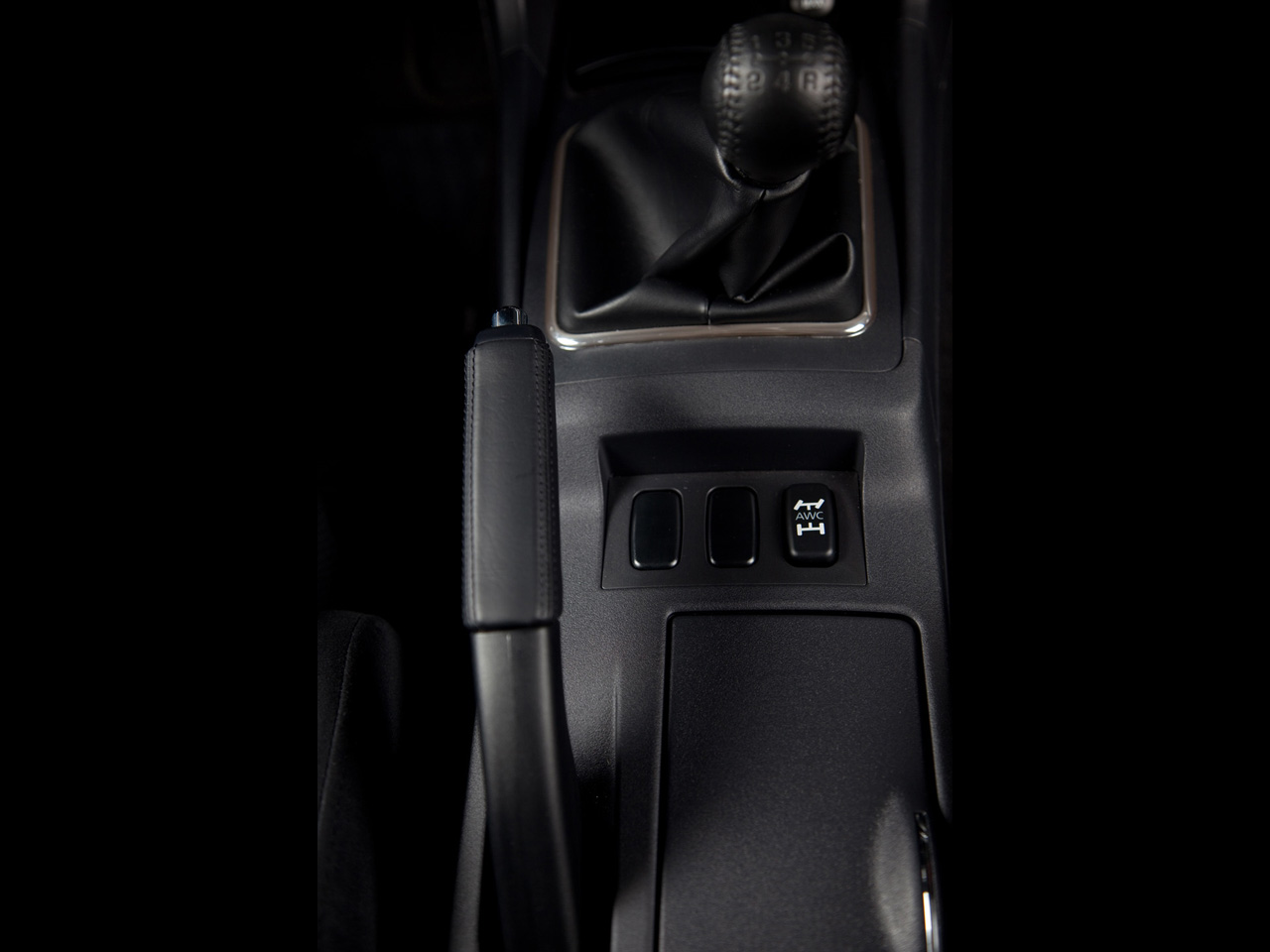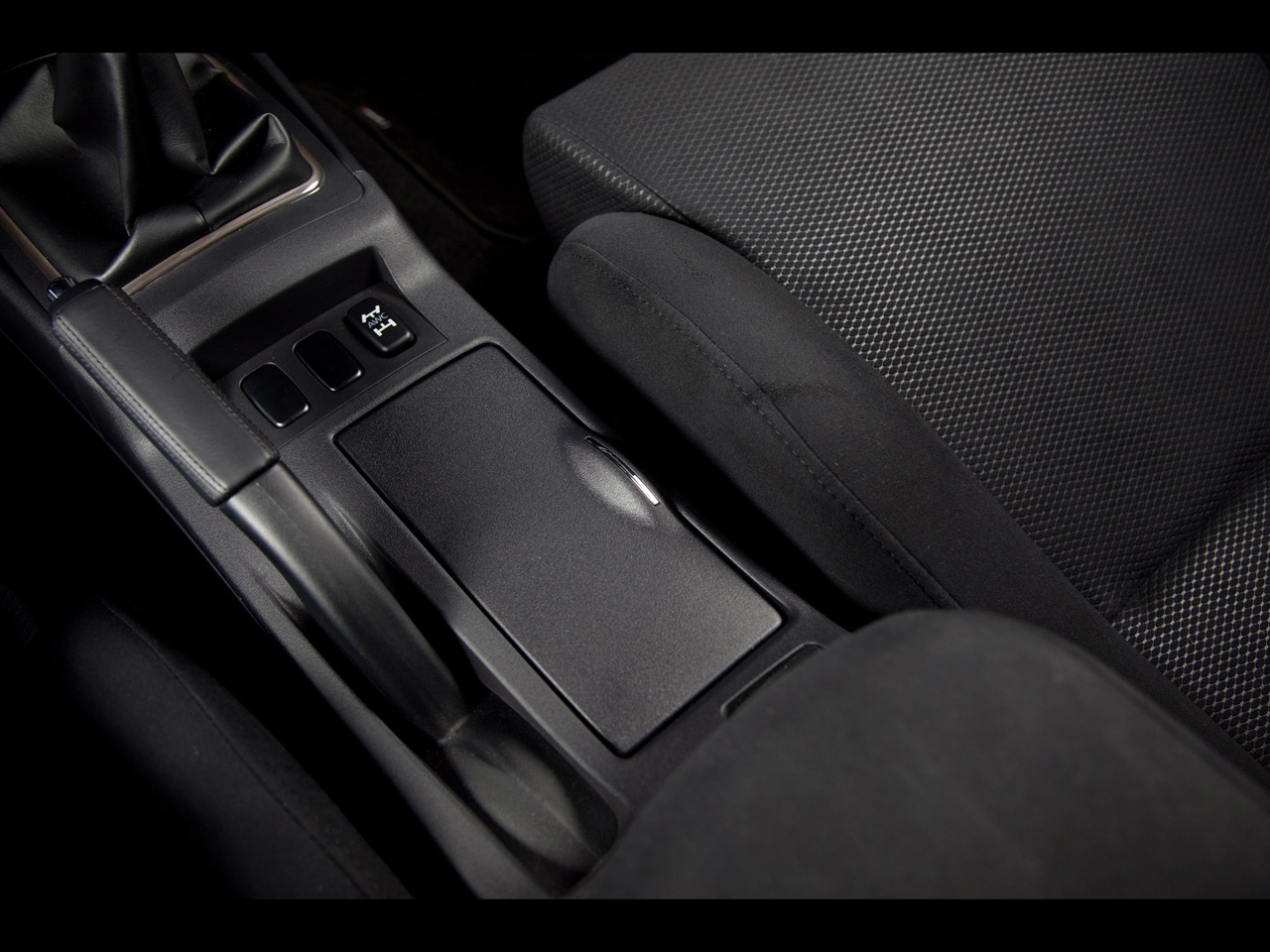2010 Mitsubishi Lancer Evolution GSR
|
Price |
-- |
Production |
-- | ||
|
Engine |
2 liter inline-4 |
Weight |
-- | ||
|
Aspiration |
turbocharged |
Torque |
300 lb-ft @ 4000 rpm | ||
|
HP |
291 hp @ 6500 rpm |
HP/Weight |
-- | ||
|
HP/Liter |
145.5 hp per liter |
1/4 mile |
-- | ||
|
0-62 mph |
-- |
Top Speed |
-- |
(from Mitsubishi
Press Release) Next-Generation Mitsubishi Lancer Evolution
Introduces Super-All-Wheel Control (S-AWC) For Supercar Handling
The previous-generation Lancer Evolution set the bar high for
handling performance, and it represented the ultimate development of
the previous platform. In the latest Mitsubishi Lancer Evolution,
Super All-Wheel Control (S-AWC) begins a new era for dynamic
handling control in high-performance sport sedans.
S-AWC is not simply the name of an all-wheel drive system, but an
advanced vehicle dynamics control network that reads and reflects
driver intent in real time. This system regulates drive torque at
each wheel by controlling a network of dynamic handling
technologies, including: Active Center Differential (ACD), Active
Yaw Control (AYC) rear differential, Active Stability Control (ASC),
and Sport ABS brakes.
Super All-Wheel Control in the Lancer Evolution will be consistent
in all world markets. Integration of Active Stability Control (ASC)
provides a significant advance in both dynamic capability and
safety. S-AWC's integrated control system provides better overall
stability and performance compared to systems in previous Lancer
Evolution models that controlled ACD and AYC (in markets where
offered) independently.
It is important to note, too, that the global platform that
underpins the 2010 Lancer (and Outlander) was designed from the
start for the highest-performance variant. The super-stiff
structure, optimized chassis systems, wider use of aluminum for the
engine, body, and chassis components, as well as greater use of
high-tensile steel, all play important roles in the Super-All Wheel
Control concept.
[Mitsubishi applies the All-Wheel Control philosophy in its
Outlander SUV, although in that vehicle AWC controls a completely
different array of components and systems designed specifically for
all-weather traction performance.]
An Evolution of Mitsubishi Four-Wheel Drive Performance
Super All-Wheel Control
is the culmination of more than 20 years of Mitsubishi road and
rally four-wheel drive innovation and experience. In the U.S., some
of the most memorable four-wheel drive road cars in recent times
have worn the Mitsubishi badge: the first Eclipse GS-X 17 years ago;
the incomparable 3000 GT VR-4 in the 1990s; the Galant VR-4 that
achieved instant cult status, and of course the Lancer Evolution
that brought Mitsubishi's rally-conquering technology and
performance to the showroom. As a result, the Lancer Evolution
offers an extraordinary level of dynamic control at each wheel,
going well beyond the capabilities of other all-wheel drive systems.
Following is a description of each part of the Super-All Wheel
Control system:
Active Center Differential (ACD) Overview
The heart of any
four-wheel drive system is the means of power distribution, which is
a key to establishing the vehicle's handling behavior. Many vehicles
today offer all-wheel drive systems, and most of these are designed
to enhance traction in slippery road conditions.
Some are as simple as a viscous coupling that passively transfers
torque away from slipping wheels in reaction to wheel spin; others
are more complex and designed to meet specific performance goals.
Lancer Evolution models have always featured a performance-oriented
full-time four-wheel drive system.
First employed on the Japanese-market Evolution VII model,
Mitsubishi's Active Center Differential (ACD) made its North
American debut in the Lancer Evolution models. Combined with a
helical limited-slip front differential (also used in the 2010
model) ACD helped raise the previous-generation Evolution's already
stellar handling performance to a new level.
How ACD Works
The ACD splits torque up
to 50:50 between the front and rear wheels using an electronically
controlled hydraulic multi-plate clutch. The ACD's electronic
control unit (ECU) optimizes ACD clutch cover clamp load for
different driving conditions, regulating the differential limiting
action between a free state (where torque is split equally between
front and rear wheels) and a locked state to optimize front/rear
wheel torque split and thereby produce the best balance between
traction and steering response.
The maximum limited-slip torque of the ACD multi-plate clutch is
about three times that of a conventional viscous coupling. The
hydraulic unit housed in the engine compartment regulates the
hydraulic pressure of the multi-plate clutch within the range of
zero to 145 psi.
The S-AWC computer takes data input from various sensors to
continuously calculate the ACD's limited-slip torque. Steering wheel
angle, throttle opening, wheel speeds, and the vehicle's
longitudinal and lateral movements are constantly measured to
determine the vehicle's path of travel. Using this data, S-AWC
determines whether limited-slip torque should be increased or
decreased at any given time.
As the previous Lancer Evolution did, this model offers three
driver-selectable traction modes for the ACD, changeable while the
car is moving using a switch on the dash: "Tarmac" for dry, paved
surfaces; "Gravel" for wet or rough surfaces, and "Snow" for
snow-covered surfaces.
In each mode, S-AWC adjusts center differential locking behavior to
suit the road conditions. The car's other dynamic handling systems
respond to the road conditions and driver input. The
multi-information monitor, located between the tachometer and
speedometer, displays the selected ACD mode and also provide status
indicators for ACD and AYC operation. The driver can see at a glance
how each differential is acting.
Active Yaw Control (AYC) Overview
The 2008 Lancer
Evolution was the first U.S. market Evolution model to incorporate
the innovative AYC rear differential, which carries over in the 2010
model. The first component of its type, AYC was first used in the
Lancer Evolution IV model in 1996. In 2003 Mitsubishi switched from
using a bevel gear to a planetary gear differential, doubling the
amount of torque AYC was able to transfer. The AYC in the 2010
Lancer Evolution retains the planetary-gear differential.
The AYC differential uses a torque transfer mechanism to control
rear wheel torque differential for different driving conditions,
enhancing cornering performance by limiting the yaw moment acting on
the vehicle. AYC also acts like a limited-slip differential by
controlling rear wheel slip to improve traction. The AYC
differential in the 2010 Lancer Evolution model now adds yaw
feedback control using a yaw rate sensor and also gains braking
force control via the Active Stability Control (ASC) system.
By controlling the amount of torque transmitted to the rear wheels
when there is less traction, or a difference in grip on the road
surface, AYC also helps to improve acceleration and stability on
slippery roads. Again, it is aided in the 2010 Lancer Evolution
model in this respect by the integration of ASC. Mainly, though, AYC
was designed as a performance-enhancing system to enable greater
stability during high-speed cornering and, ultimately, higher
cornering grip.
How AYC Works
The AYC differential
actively splits torque between the right and left rear wheels,
effectively changing the yaw moment of the vehicle as needed for a
given cornering situation. Like ACD, AYC is controlled by the S-AWC
computer, using inputs from steering wheel angle, throttle opening,
individual wheel speeds, and longitudinal and lateral movements.
The AYC features two sections - the rear differential and the
left/right power split control section. Within the power-split
section are two hydraulic clutches - one each for the left and right
axles. During cornering maneuvers, the right or left clutch - taking
input from the S-AWC computer - will act on the differential to
increase torque to the outside rear wheel and reduce the torque
level to the inside rear wheel. This action changes yaw movement of
the vehicle, influencing it to steer inwards and reducing the amount
of slip on the front tires, thus reducing understeer.
Active Stability Control (ASC) Overview
Integrated management of the ASC and ABS systems allows S-AWC to effectively and seamlessly control vehicle dynamics when accelerating, decelerating or cornering. The ASC system, which includes stability control and traction control, helps to maintain optimum traction by regulating engine power and the braking force at each wheel. ASC helps the driver follow a chosen line more closely by comparing the car's path (as determined from yaw rate sensor data) to the desired path (as determined from steering inputs) and applies individual wheel braking or throttle control to correct any divergence. ASC also enhances vehicle stability by helping to prevent wheel spin on slippery surfaces, and helping to prevent sliding as the result of sudden steering inputs.
How ASC Works
It is important to note
that S-AWC does not use stability control to vary torque
distribution, as some other all-wheel drive systems have done: It is
S-AWC that actively controls front-to-rear torque distribution
through the ACD, and rear wheel side-to-side torque distribution
through AYC. A helical limited-slip front differential reacts to
torque input to govern side-to-side torque distribution at the front
wheels.
With ASC activated, S-AWC can exert even more control over vehicle
behavior in on-the-limit driving situations. Increasing braking
force on the inside wheel during understeer and on the outer wheel
during oversteer situations, ASC works in concert with torque
transfer regulation to allow higher levels of cornering performance
and vehicle stability.
Using engine torque and brake pressure information in the regulation
of the ACD and AYC components allows S-AWC to determine more quickly
whether the vehicle is accelerating or decelerating.
ASC is programmed to allow performance driving and can be turned off
for track driving; turning off ASC does not compromise operation of
the car's ACD or AYC differentials. Of special note to track racers,
however, holding down the "ASC off" button for three seconds will
also disengage the AYC brake-control function.
Sport Anti-lock Braking System (Sport ABS)
ABS can help the driver to maintain steering control and help keep the vehicle stable by preventing the wheels from locking under heavy braking or when braking on slippery surfaces. The addition of yaw rate sensors and brake pressure sensors to the Sport ABS system has improved braking performance through corners compared to the previous-generation Lancer Evolution. (See Chassis section in this press kit for details on braking system.)
Helical Front Differential
The helical-type limited
slip front differential constantly biases torque to the wheel that
has more traction. This type of differential reacts to torque input
- it is not actively controlled like ACD or AYC. Under straight-line
acceleration, power remains evenly split between the front wheels.
While cornering or accelerating out of a turn, the helical LSD
directs power away from the inside wheel and toward the outside
wheel, allowing the driver to begin accelerating earlier and exit
the turn at a higher speed, without losing traction.
The helical front differential can also compensate for loss of
traction when the front wheels are on slippery surfaces, biasing
torque to the wheel with the best traction. Because the front
differential uses gears, it is stronger and more durable than other
types of LSDs, with no plates or clutches that can wear out and
require replacement.



